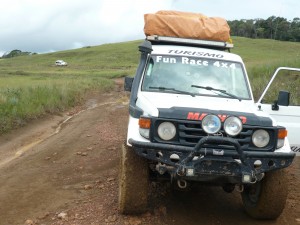The eight hour drive to the Gran Sabana offers the prospect of getting to know our travelling companions a little better and Manuel and Doug provide a splendid run down on the local delicacies we can expect to sample along the way. My personal favourite is cuache – a hot chilli sauce made from termites and ants, ‘boiled to remove most of the cyanide’ – nice. If that feels too tame there are the finger-fat palm tree grubs (big maggoty things basically) that, according to Doug, ‘taste like almonds, dipped in a bit of shit’.
The drive takes us through cacao growing country – chocolate trees to you – before giving way to the shale oil fields that dominate the East of the country. If the nodding donkeys and flame stacks belching rubber-black smoke weren’t enough to confirm we are in oil country, the stop for fuel is an eye opener. In a country where the price of bolivars looks more like a homeopathic potency than an exchange rate, the cost of 100 litres of diesel is a paltry 4 bolivars.
This is too small a number to calculate accurately but equates to less than one quarter of a US cent or, as near to free as makes no difference. “People may be starving and at the mercy of criminal gangs,” says Manuel, “but without a car in Venezuela you are nothing. The last time they tried to raise the price of fuel we came close to a civil war.”
This evening we cross the mighty Orinoco (named after the greatest of the Wombles) and into Bolivar state. We visit the obligatory statue of Simon De Bolivar in the town square and make approving noises over the bullet hole in the cathedral wall where he executed his brother-in-law (which sounds very like one of our family get-togethers).
Tomorrow we plunge further south into the Gran Sabana and the adventure begins to take shape. The excitement in the group is palpable and even the prospect of almonds dipped in shit cannot dampen our enthusiasm for what is to come.




